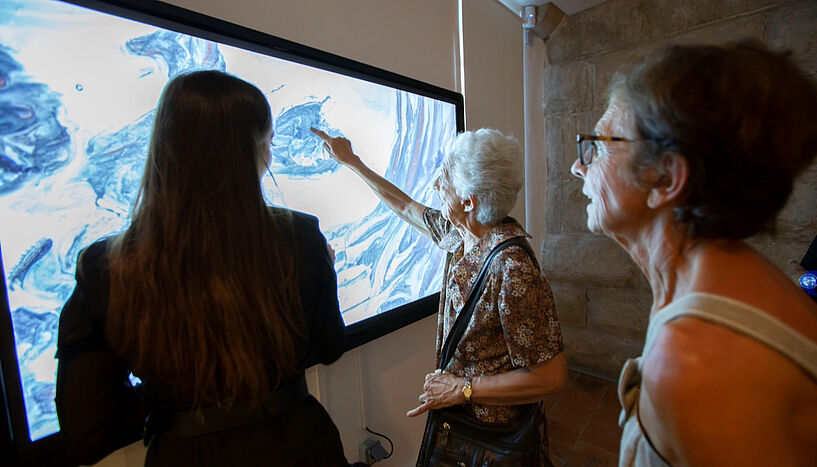Novel interactive technology boosts people’s enjoyment with artworks
23. November 2022
Pic. 1: In this experiment, participants had the opportunity to enlarge the artworks and explore them in great detail. (C: ARTMYN)
However, the interactive technology did not improve memory for the artworks
A new study led by psychologists Domicele Jonauskaite and Helmut Leder, both from the University of Vienna, and Christine Mohr from the University of Lausanne investigated how interactive exploration of extremely high-resolution reproductions of paintings and cultural objects influenced users’ aesthetic appreciation. They concluded that novel interactive technology boosted engagement with art by making it appear more interesting and pleasant. However, it did not improve memory.
Digital technologies reshape the way we engage with the world around us. Thanks to high-resolution digital reproductions, we can finally explore foreign places and objects in unprecedented detail, from the comfort of our homes. Museums are adapting to the technological advancement by making their collections more widely accessible and interactive. Just think of artworks with augmented reality or completely virtual exhibitions.
Interaction with artworks
In the current study, the researchers worked with the start-up company ARTMYN, which was founded at the École polytechnique fédérale de Lausanne (EPFL). ARTMYN uses advanced computational imaging solutions allowing to create high-resolution scanning of artworks and cultural artefacts, some reaching a billion pixels. The resulting three dimensional digital scans can be explored according to the observers’ liking through an interactive digital interface. Observers can zoom deep into the artworks and cultural artefacts to see the reliefs of paint brush strokes and appreciate materiality. They can manipulate the pieces by moving and turning them to bring them into any desired viewpoint; or they can relight them by virtually changing the position of illumination, as a curator would do with the real artefact.
The researchers explored whether such interactive features would boost art appreciation and memory. They ran two research studies – a well-controlled study in the laboratory and a field study at the Fondation Martin Bodmer museum. Their results showed that users experienced more pleasure, felt more interested in the pieces, felt they explored the pieces more intensely and felt they learned more when they had an opportunity to digitally interact with the artworks and cultural objects, as compared to no interaction possibility or when seeing the same pieces as physical objects. However, digital technology did not help remember the pieces better. Users were also motivated to recommend the technology to their friends and use it in the future.
Promising tool for exploring artworks
In the current study, the scientists showed a promising interactive digital tool for exploring artworks and cultural objects. "It could be a new tool for museums willing to engage the visitors with their collections and attract new ones. Or, it might prove to be beneficial in educational and marketing settings, facilitating teaching and learning or boosting sales of promoted artworks in auctions. The technology also has multiple technical applications, such as enhanced readability of some cultural objects (e.g., cuneiform tablets), improved damage identification, and more accurate and easier authentication procedures", says first author Domicele Jonauskaite from the University of Vienna.
Publication:
Jonauskaite, D., Dael, N., Baboulaz, L., Chèvre, L., Cierny, I., Ducimetière, N., Fekete A., Gabioud, P., Leder, H., Vetterli, M., & Mohr C. (in press). Interactive digital engagement with visual artworks and cultural artefacts enhances user aesthetic experiences in the laboratory and museum. International Journal of Human-Computer Interaction.
DOI: 10.1080/10447318.2022.2143767
Picture:
Pic. 1: In this experiment, participants had the opportunity to enlarge the artworks and explore them in great detail. (C: ARTMYN)
Scientific contact
Univ.-Prof. Dr. Helmut Leder
Institut für Psychologische Grundlagenforschung und ForschungsmethodenUniversität Wien
1010 - Wien, Liebiggasse 5
T +43-1-4277-47110
helmut.leder@univie.ac.at
Dr. Domicele Jonauskaite
Institut für Psychologie der Kognition, Emotion und Methoden Fakultät für Psychologie1010 - Wien, Liebiggasse 5
+43-1-4277-47107
domicele.jonauskaite@univie.ac.at
Further inquiry
Theresa Bittermann, BA
Media Relations, Universität Wien1010 - Wien, Universitätsring 1
+43-1-4277-17541
theresa.bittermann@univie.ac.at
Downloads:
20221123_Jonauskaite_Abb1_01.jpg
File size: 2,45 MB
